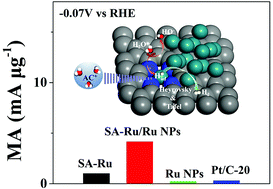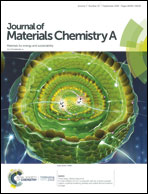Electronic structure engineering of single atomic Ru by Ru nanoparticles to enable enhanced activity for alkaline water reduction†
Abstract
Regulation of the electronic structures of metal centers represents a robust strategy for enhancing the activity of electrocatalysts. Herein, we report the crafting of hybrid electrocatalysts comprising both single atomic Ru (SA-Ru) and Ru nanoparticles (NPs) supported on porous N-doped carbon (PC), in which the electronic structures of SA-Ru were effectively optimized by nearby Ru NPs to achieve great enhancement of the hydrogen evolution reaction (HER). The resulting SA-Ru/Ru NPs/PC displayed ultrahigh activity for HER in 1 M KOH with a mass activity of 4.2 mA μgRu−1 at −0.07 V vs. RHE; this activity was 14 times that of commercial Pt/C, representing the largest reported value among the Pt-free electrocatalysts. In addition to the ultrahigh activity, the composite possessed the outstanding stability of 24 h and rapid HER kinetics (i.e. Tafel slope: 31.8 mV dec−1). The experimental and theoretical results matched well with each other and unambiguously indicated that the control over the electronic structures of SA-Ru and the advantageous PC support (i.e. its hierarchical porous nanostructures and superhydrophilic surface) jointly contributed to the exceptional performance.



 Please wait while we load your content...
Please wait while we load your content...